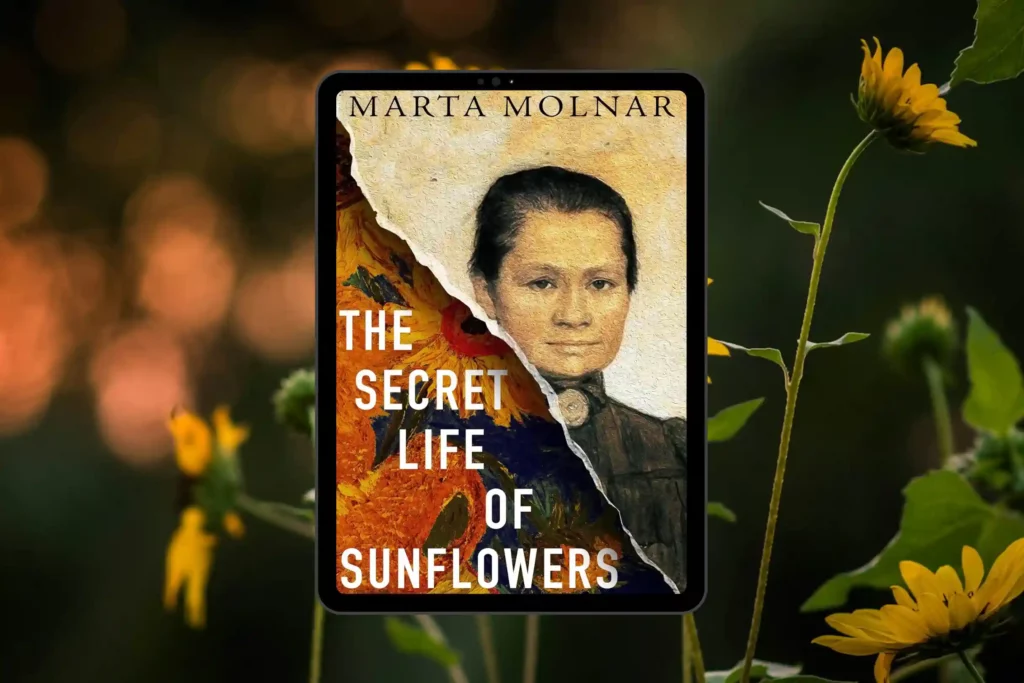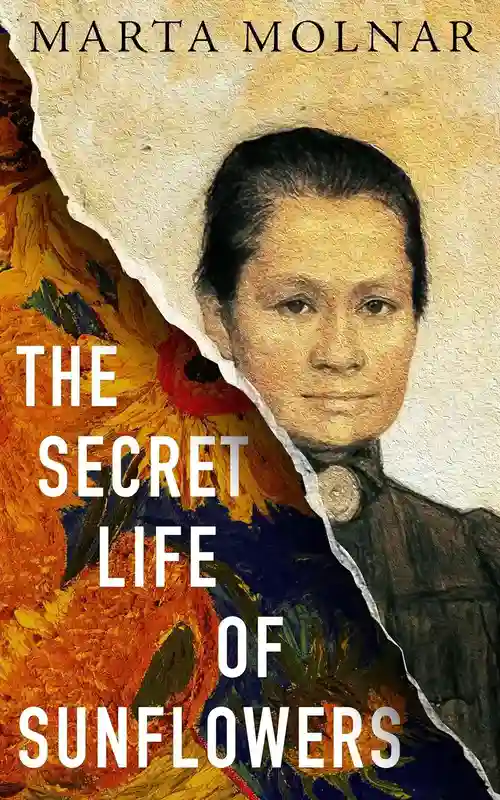This post may contain affiliate links. Read more here.

Note: the following guide contains spoilers, as well as references to critical plot points and the conclusion of The Secret Life Of Sunflowers by Marta Molnar.
The Secret Life of Sunflowers is a historical fiction piece inspired by the letters of Johanna Bonger van Gogh, the sister-in-law of the famous painter Vincent van Gogh.
The novel unfolds the story of Emsley Wilson, a fictional character connected to Johanna through the latter’s diary and letters. Emsley inherits these documents from her artist grandmother, Violet Velar, just before Violet’s passing.
As Emsley delves into Johanna’s struggles to promote her brother-in-law’s art, she discovers inspiration to overcome her own challenges in a society where both Emsley and Johanna confront gender norms.
The Secret Life Of Sunflowers by Marta Molnar
Marta Molnar, the author of this novel, initially worked in the corporate world but later pursued a career change by taking writing courses at Seton Hill University. Despite facing rejections, she authored and published more than 60 novels as Dana Marton. The Secret Life of Sunflowers stands out as a self-published work that gained popularity after Molnar shared it with fans on social media.
Recognized for her contributions to romantic fiction, Marta Molnar, writing as Dana Marton, has earned prestigious awards such as the Daphne du Maurier Award of Excellence, the Reader’s Choice Award, and the RITA Award.
In this guide we will go through the complete summary and ending explanation for The Secret Life Of Sunflowers by Marta Molnar. Enjoy! ✨
The Secret Life Of Sunflowers Summary
The Secret Life Of Sunflowers tells two stories: Emsley Wilson, an auctioneer in present-day Los Angeles, and Johanna Bonger van Gogh, living in the late 19th-century Netherlands as the sister-in-law of the renowned artist Vincent van Gogh.
As the novel begins, Emsley visits her grandmother, Violet Velar, an artist now residing in a facility after a stroke. Emsley’s auction house, managed with her friend Diya and now-ex-boyfriend Trey, is struggling, compounded by the unexpected romance between Trey and Diya. Violet, facing health issues, hands Emsley a stack of old Dutch letters and a diary, initially presumed to be Violet’s but is revealed to be Johanna Bonger’s upon reading.
Returning to work, Emsley faces the dissolution of her business as Diya sells her shares to Trey. Determined to keep the business, Emsley must either buy Trey’s shares or dissolve the company. Amidst this, Violet suffers another stroke, leading Emsley to New York. Tragically, Violet passes away, leaving Emsley emotionally devastated.
Emsley, dealing with grief, embarks on the task of emptying Violet’s recently sold house. In the process, she encounters Bram Dekker Sr., Violet’s attorney, and his grandson Bram Jr., developing a romantic interest in him despite his apparent marriage. Meanwhile, Emsley discovers her potential connection to Johanna and Vincent van Gogh through the diary and Dutch letters.
Cleaning out Violet’s house becomes a collaborative effort with Bram Jr., who assists Emsley. Uncovering valuable antiques, Emsley works with Sergei Prokhorov, Bram’s cousin and an antiques dealer. She also befriends Strena, a performance artist using Violet’s studio. As Emsley delves into Johanna’s life, she learns about Violet’s past, including a traumatic incident at a party in 1965.
Negotiating with Trey to preserve her business, Emsley proposes her plan to Bram, Sergei, and Strena, successfully securing their investment. Emsley eventually confronts Senator Tayor Wertheim about Violet’s assault. Discovering that the sale of Violet’s house is in jeopardy, Emsley decides to buy it herself.
Johanna’s narrative serves as a source of inspiration for Emsley, providing solace during the challenging times of sustaining her business and coping with her grandmother’s passing. In Johanna’s twenties, living in Amsterdam with her family, she navigates intricate relationships and pivotal moments.
Johanna’s brother, Dries, working in the Parisian art world, introduces her to Theo van Gogh, Vincent’s brother, who proposes marriage. Initially hesitant and hoping for a proposal from Eduard, Johanna declines but agrees to correspond with Theo. Frustrated with failed attempts at teaching English, she takes Dries’ suggestion to visit Paris for Christmas, leading to the blossoming of her friendship with Theo. When he proposes again, Johanna accepts, marking the beginning of their marriage.
The couple returns to the Netherlands, where Theo supports and promotes Vincent’s artistic endeavors. Vincent’s struggles with mental illness culminate in his tragic suicide in 1890, leaving Theo devastated and battling depression. Despite Johanna’s efforts to uplift him, Theo’s mental health deteriorates, resulting in his confinement to a psychiatric hospital. Johanna’s visits are often rejected, and eventually, Theo also passes away.
Determined to fulfill Theo’s vision of showcasing Vincent’s art, Johanna returns to the Netherlands with their young son. Faced with challenges as galleries show no interest, she opens a boarding house for support. Undeterred, Johanna takes on the unconventional role of representing Vincent’s work herself. Through persistent efforts and letter writing, she secures an exhibition in the Netherlands, successfully establishing Vincent van Gogh as one of the leading artists of his time.
Captivated by Johanna’s story, Emsley conducts her research with the assistance of Strena, who translates the Dutch letters. Emsley uncovers a familial connection as Clara, the recipient of Johanna’s letters, turns out to be Violet’s great-aunt. The novel concludes with Emsley’s revelation that Violet owned an original painting by Vincent van Gogh.
The Secret Life Of Sunflowers Ending Explained
So, what happens at the end of The Secret Life Of Sunflowers?
As the novel concludes, Emsley and Bram embark on a romantic relationship, marking a significant evolution in Emsley’s character. Initially hesitant due to a misunderstanding about Bram’s marital status, Emsley’s commitment to her ethical principles shines through. Refusing to date a married man reflects her strong moral code. When she discovers that Bram is a widower mourning the loss of his wife, her perception of him shifts, and she appreciates his honor and commitment.
The epilogue hints at Bram’s enduring role in Emsley’s life, solidifying their connection. Emsley’s decision to reject Trey’s offer to renew their relationship further underscores her personal growth throughout the novel.
A pivotal aspect of Emsley’s transformation is her involvement in Strena’s performance art. Initially apprehensive, especially about a piece that requires her nudity, Emsley grapples with societal expectations of modesty. However, her participation becomes a tribute to Violet, given Strena’s association with her. The experience proves uplifting and liberating for Emsley.
Johanna’s journey towards achieving recognition for Vincent’s work unfolds with persistence and resilience. Despite initial reliance on Theo’s connections in the art world, Johanna faces rejection. Her bravery and determination defy late 19th-century gender norms that deemed such qualities unfeminine.
Running a boarding house becomes a means of financial support for Johanna and her son, emphasizing her independence. Johanna’s engagement with the artistic and intellectual community in Amsterdam provides mental stimulation and inspiration.
Facing challenges in garnering support for Vincent’s paintings, Johanna insists on her limited knowledge but perseveres. Her decision to represent Vincent’s work herself is a risky move that ultimately contributes to her success in achieving Theo’s dream. Johanna’s journey showcases her ability to adapt, learn, and establish herself in a world that often limited women’s roles and aspirations in the late 19th century.
Johanna’s unwavering loyalty to Theo persists even after his death. She considers herself still married to him in a spiritual sense and remains closed to the idea of pursuing a romantic relationship with another man.
Even when Janus expresses interest, Johanna keeps their connection strictly platonic, mirroring Emsley’s cautious approach in her early interactions with Bram. Despite the generational gap between them, Emsley is drawn to Johanna, finding inspiration in her story and recognizing shared qualities with her beloved grandmother, Violet.
A pivotal moment in Emsley’s life unfolds as she uncovers the truth about her grandfather’s identity and her family’s link to Johanna Bonger. While Violet never reported Taylor Wertheim’s assault to the authorities or sought justice, Emsley’s confrontation with him provides a form of closure. The decision of whether to disclose this revelation to her mother remains uncertain, but Emsley no longer grapples with the mystery of her grandfather’s identity, understanding why Violet kept him a secret.
Moreover, Emsley takes pride in her connection to Johanna. Initially drawn by the possibility of being directly related to Vincent van Gogh, Emsley’s focus shifts as she delves deeper into Johanna’s story.
It is Johanna’s dedication and perseverance in the face of adversity within a patriarchal culture that captivates Emsley. This newfound knowledge serves as a source of inspiration, shaping Emsley’s values and becoming a guiding model for her future endeavors.
How did you like the ending of the novel? Happy reading! ❤️

Christine Strayhorn
Tuesday 26th of March 2024
Your insights and summary were invaluable. Thank you for this great information.